Arsene Lupin: Once a Thief review
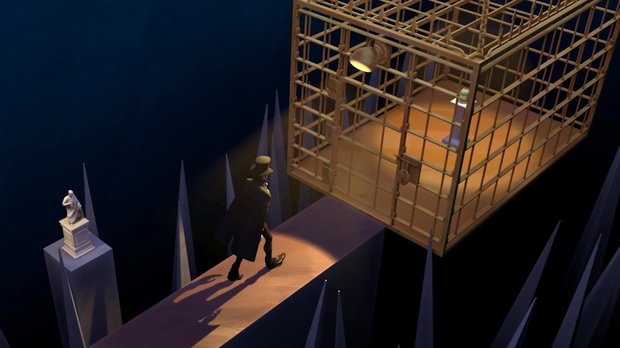
- 0 Comments
Crime sometimes pays, as evidenced by the literary gentleman thief in his easy but entertaining first adventure
The first time I heard of the literary character Arsène Lupin was when French actor Omar Sy starred in the Netflix series inspired by the Maurice Leblanc stories. I loved that show, and afterwards borrowed a couple of the books from the library. It was so much fun to read about this lovable villain, a gentleman thief usually depicted in a top hat and a cloak who was a French contemporary of Sherlock Holmes. So I jumped at the chance to play Arsene Lupin: Once a Thief, developed by Blazing Griffin (who also made some Hercule Poirot games, all published under the Microids label), as if it was a priceless treasure I wanted for my own collection. And while it is only a slightly interactive version of a linear story-within-a-story without much challenge or even any risk, I immensely enjoyed the chance to play both as the criminal AND the police in this fun cat-and-mouse-style detective game.
Once a Thief is framed by a private conversation between Leblanc and his literary creation as if the expert burglar and master of disguise were a real person. The two men are sitting in armchairs in front of a fireplace, their backs turned to the player, with only their arms visible on the rests as they reminisce about Lupin’s adventures. This back-and-forth between the pair allows for different perspectives of the events unfolding, as Leblanc tells Lupin the facts of his crimes as he’s heard them, and then Lupin corrects him with his version of how things really happened, with Leblanc occasionally questioning his version of events as well.
Gameplay begins with a short prologue in which you have to steal a Fabergé egg from a heavily fortified chateau, guarded by both men and dogs – not to mention all kinds of booby traps and technological security gadgets. Things start off a little bumpy, as the first task you are given is a timeline puzzle. You are shown a schematic of the current situation, similar to a blueprint, with a list of possible actions next to it. You then need to arrange a correct timeline by putting these actions in a logical order, building an appropriate chronology for what Lupin must do to overcome the obstacles he’ll face – in this case the security measures in the chateau.
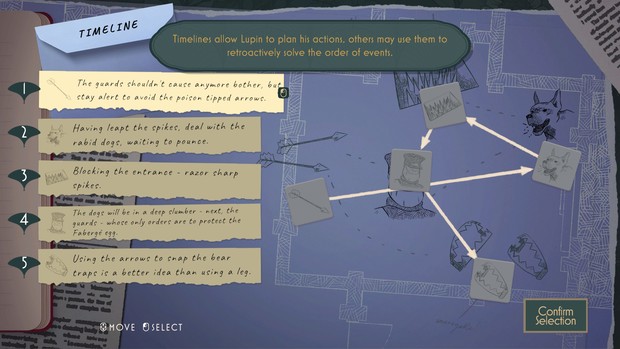
You will have to solve several different versions of this sort of puzzle throughout the game. While I got a better hang of it as the story progressed, I must admit the first time was actually quite confusing to me and took me several tries to solve. There is always a correct order to these puzzles, but it is not always apparent what the different steps are supposed to be. However, in the end it doesn’t matter because you can’t really do anything wrong. You are never penalized for putting the actions in the wrong order, and you’re given infinite tries to get it right. Basically, even if you don’t immediately see the logic in them, you can solve them through trial and error. It could just take a while, and you might get a little frustrated during these parts.
There isn’t much payoff for successfully accomplishing that very first one, either, because after you have finally figured out the correct sequence, you don’t even get to see Lupin in action. The screen remains white while you hear all kinds of sound effects as the traps are sprung and the guards and dogs are dispatched, only to get a view of the room with the final result: Lupin standing victorious over both men and canines lying unconscious. This is one of the many times the game demonstrates a lack of animations beyond the playable character walking around.
After completing the first timeline puzzle, the rest of the prologue plays out like a traditional adventure, detailing the steps taken and puzzles solved by Lupin to perpetrate his crime. In subsequent chapters, you will play through four more crimes not only as Lupin himself (the robberies of two more chateaus, a jewelry theft on board a ship, and his escape from prison) but also as Inspector Ganimard, Lupin’s greatest nemesis. This surprised me, because I was expecting a game with Lupin as the sole main character, and wasn’t anticipating an experience where I’d effectively be chasing myself.
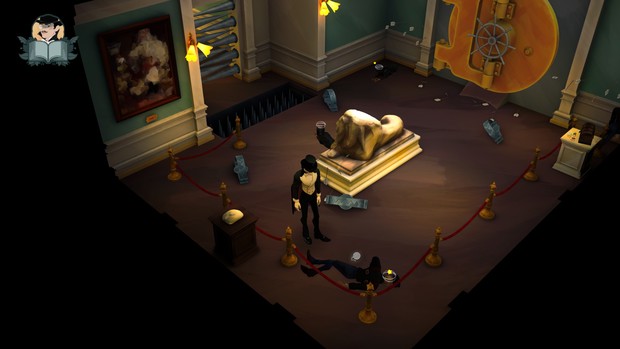
Thankfully it turned out to be a very pleasant surprise. After a brief stint playing photojournalist Bernard d’Andrésy on the transatlantic voyage from France to New York, where Lupin is rumored to be disguised and waiting to strike, Ganimard arrives to take over the investigation to figure out which of the ship’s passengers is the thief in disguise, and who he is planning to rob. Ganimard’s segments throughout the game feature traditional detective gameplay as you try to figure out how exactly Lupin is planning his “impossible” thefts.
The most fun, however, is always in the subsequent chapters where you get to play as Lupin actually executing the plan by finding ways past all the obstacles, and witnessing first-hand how the clues Ganimard found – many of them red herrings, it turns out – got there in the first place. This playful juggling with the story’s chronology results in a fun and dynamic form of storytelling. I truly enjoyed this way of unraveling the narrative, going forward and back in time, because it keeps you guessing what’s really happened. And it is a real hoot to see Ganimard, who thinks he is always hot on Lupin’s tail, discover in the end he never even came close.
Once a Thief is fully playable with either controller, keyboard, or mouse, but being a point-and-clicker at heart, I chose the mouse-only control system. You get an isometric view of the rooms, and you can rotate the camera around 90 degrees at a time by scrolling the mouse wheel. I don’t know if this is common in isometric games (the ones I have played only allowed zooming in and out, with a fixed perspective otherwise) but I found it very artistically done, and the camera moves smoothly, making it a real pleasure to peruse locations this way.

Left-clicking allows you to examine or manipulate hotspots, which are always indicated by a magnifying glass when you hover over them. Right-clicking on them opens up your inventory so you can try to use something there, but this option only becomes available once you have collected the correct item, so you never have to try everything on everything. It’s here I noticed that not all dialogue text is voiced. When Lupin comments on a particular hotspot, he will just make a small noise like a grunt or a hum, but he won’t speak the subtitled descriptions out loud, which I found disappointing. Only when engaging other characters in conversation is the dialogue fully voiced. But here as well, the characters aren’t animated. Conversations are shown in visual novel style, with portraits of both parties standing on either side of the screen, dialogue options shown in the middle, with a couple of different expressive yet static images for each character depending on how the conversation goes.
The investigative gameplay resembles any Hercule Poirot or Sherlock Holmes games you might be familiar with. You search all locations for clues, then you have to make deductions by connecting them logically on a board, giving you new options to follow up on. When you are able to make a link between two pieces of evidence, this will be shown on a notebook icon at the top left of the screen. The notebook gives you access not only to the deduction board but also your inventory and documents you have found, the profiles of the characters you have met, and a task list. Once in front of the board, you simply select one piece of evidence and can draw a line to connect it with another piece.
As with devising a timeline of possible actions, you get infinite tries to get deductions right. If you make a wrong connection, a cross will appear over the evidence you tried to combine, and you can basically experiment with everything that way. Sometimes I literally had to do that when I really didn’t see what the game wanted me to see. It is harder than you think! But nothing beats the satisfaction of immediately making the right deduction. I always love it when an adventure game makes you feel smart, and Once a Thief definitely does that, because it doesn’t assume its players are stupid. While it is never very challenging, it never just hands you the solution on a silver platter either.
I did find the size of the deduction board annoying, though. The evidence is spread out too far, and even when manually zoomed out to the max, the board is still too big to fit entirely on the screen. I never got a decent overview of all evidence at once that way, and I found myself constantly having to scroll in all directions. I’m sure this could have been made far more user-friendly.
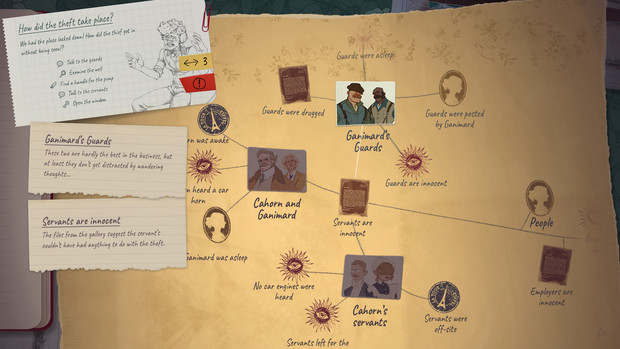
You will face the occasional inventory puzzle, though they are barely worthy of being called that. You might find the stray item lying around, but you won’t be able to pick it up before you have found the place to use it. Lupin will say something like, “I don’t need it right now, but it might be interesting for later.” Then when you explore further and locate the obstacle that requires it, it will be totally apparent what is needed. The opposite is possible as well: some hotspots only become available after you have done certain other tasks that progress the plot, even though the objects in question have always been visible in the environment.
The true puzzles, next to the deduction board and the timeline arrangements, are the many codes you need to find to open safes and lockboxes. Sometimes you can get the necessary information from other characters, occasionally you need to search the environment for hidden symbols, while other times you must carefully read notes or other documents. Finding the correct code was always my highest feeling of accomplishment, since it felt like playing through an escape room.
There’s a wide variety of characters to speak to throughout the game. There are several servants in the chateaus Lupin wants to rob: an art-collecting baron, the ship’s captain, the first mate, a narcissistic American, a couple of rich ladies, several of Ganimard’s assistants, and some prison guards, among others. When playing as Lupin, usually after having constructed a disguise for yourself, you will have to try to convince people to help you by choosing the correct dialogue options. Similar to the lack of vocal hotspot commentary, the choices you make in conversation aren’t spoken out loud by the playable character. This was unexpected and made me miss a couple of details early on because I clicked too fast, thinking I would hear the complete sentence anyway.
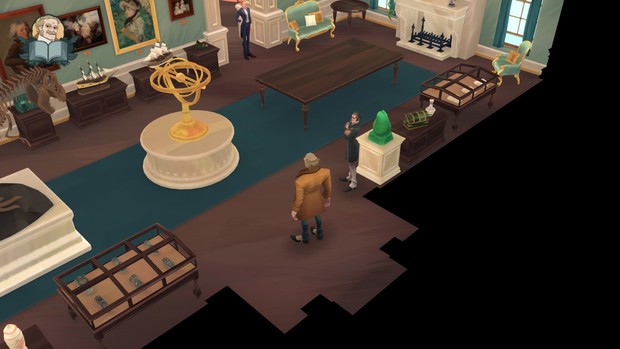
If you fail to trick another character, you don’t have to worry, as a short fireplace cutscene will begin, in which either Lupin or Leblanc tells the other that’s not what happened and he should get his facts straight. You are then taken back to the start of the conversation as if nothing happened, and just as with the other aspects of the game, you get unlimited tries to get it right. You might still get frustrated, however, because at times it is not always obvious how you have to handle an interrogation. It all depends on the personality of the other party.
The fireplace cutscenes also weave Once a Thief’s ten playable chapters together. Lupin will congratulate Leblanc on how well he has captured the personality of Ganimard on paper, and in turn Leblanc will applaud Lupin’s ingenuity in fooling the inspector. The two men’s dialogue text appears at the bottom and auto-advances. I found this very inconsistent with the playable sections of the game, where you need to click to advance the text.
Even though Leblanc, Lupin and Ganimard speak English, they have thick French accents. There are other characters that sound unmistakably American, while one of the many servants you'll meet has clear German roots, and there's even a certain British detective coming to Ganimard's aid who definitely sounds the part. To my ear it seemed as if the accents were slightly exaggerated, the way some stage performers might oversell their roles. But far from being off-putting, this made the game feel more theatrical and dramatic to me, befitting such a swashbuckling tale. Detective game aficionados will probably even recognize Baron Cahorn's voice actor as Leslie Clack, who performed as Hercule Poirot in 2023's Agatha Christie – Murder on the Orient Express.
Occasionally you will be treated to beautiful book illustrations showing how the story further unfolds in between chapters, as the voice of Maurice Leblanc recites the accompanying lines from the stories he wrote. While you play, you can also earn in-game achievements. Most of them you will automatically receive during the natural course of events, but for other optional ones you will have to do something extra. Each achievement (referred to as “collectables” here) unlocks a piece of artwork you can view through the game’s main menu.
The action is accompanied by a jazzy “spy movie” soundtrack filled with string instruments such as violins, cellos, and double bass, but also the piano and brass instruments like the saxophone. It reminded me of John Williams’ compositions for Spielberg’s Tintin movie. It’s the perfect playful accompaniment for a game featuring such a lovable rogue.
Once a Thief doesn’t allow manual saves. Instead it uses a checkpoint-based autosave, but it wasn’t very apparent to me when exactly the game recorded my progress, making me anxious whenever it was time for me to quit, not knowing how much of the game I would have to replay once I returned to it. From the game’s main menu, however, there is the option to revisit any chapter you’ve finished or restart the current chapter.
Final Verdict
Although I expected to play only as Lupin himself, the playful way in which Arsene Lupin: Once a Thief's narrative chronology is broken up between Lupin carrying out his heists and Ganimard trying to figure out how he does them is very fun. Some of the puzzles are fairly straightforward and overly forgiving, with unlimited tries and no repercussions when you do something wrong, but the more traditional investigative puzzling is rewarding to solve, and whenever I succeeded in linking evidence correctly, I felt as if I was donning a black cloak and top hat of my own in plotting my latest heist. The music is great, the isometric scenes fun to rotate and explore, and the supporting cast just begs to be fooled by Lupin. Since I’ve read some of the Leblanc books, I recognized some plot elements here and there, like how Lupin escapes his unavoidable arrest, but it’s certainly not necessary to know anything about the character going in. Just like his more famous British and Belgian contemporaries, Lupin is a character straight out of literary fiction who was long overdue a lead role, and I’m sure he will charm his way into the hearts of those who aren’t already familiar with his antics as well.
Hot take
Arsene Lupin: Once a Thief doesn’t pose much challenge or risk, but the chance to play both as the criminal AND the police in this fun cat-and-mouse-style detective game makes it quite a catch.
Pros
- Several different gameplay styles
- Jazzy soundtrack gets you in the right trickster mood
- Changing story chronology results in fun and dynamic storytelling
- Multiple playable characters offer a playful view from both sides of the law
Cons
- Not a very strong first act
- Rather low on animations
- Not all dialogue is voiced, and no consistency in advancing text
- Deduction board is too big to handle efficiently
Johnny played Arsene Lupin: Once a Thief on PC using a review code provided by the game's publisher.











0 Comments
Want to join the discussion? Leave a comment as guest, sign in or register in our forums.
Leave a comment